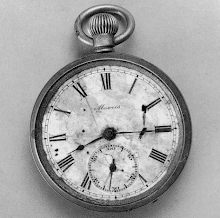skip to main |
skip to sidebar
During World War I, American University had turned over its campus to the army ... The army leased the fields and wooded dells around the campus to use as a proving ground. They lobbed mortars and dug trenches. They tested chemicals on dogs, goats, and other animals, and on men as well. Many years before the area became Spring Valley, the dell behind the campus earned the nicknames "Death Valley" and "Arsenic Valley." The soldiers called the hilltop campus Mustard Hill ... After the U.S. Army Corps on Engineers closed the investigation and declared the cleanup of Fifty-Second Court complete, questions arose about another spot across Spring Valley, where houses had been built on the back [south] side of the American University campus ... The corps resisted reopening the investigation, but when they did, they promptly found new chemical weapons detritus, including pits containing hundreds of munitions, some with mustard agent inside, buried in the backyard of the South Korean ambassador's residence.

The new discoveries embarrassed the Army Corps on Engineers and stirred lingering suspicion about the army's commitment to cleaning up Spring Valley. The environmental remediation, estimated to eventually cost more than $300 million, was still ongoing at press time. On a crisp November morning in 2012, I stood in a gaggle of reporters in the driveway of a stately brick two-story house ... More than ninety years earlier, Sergeant Maurer had stood on the same hillside and posed beside the pit called Hades with the jars and bottles of chemicals lined up next to him. The house in front of us had been built atop that spot [sic], and the photo helped to pinpoint the pit's location beneath the back patio of that house ... The cleanup of the property had proved so complicated, with so many lingering questions about what was still buried there, that the army decided that the easiest route was simply to demolish the house altogether and cart away whatever lay beneath ... In a sense, Hellfire Boys began that day.
... The more I searched for information about the American University Experiment Station, the more puzzled I grew over how little was known about what had happened there. It seemed strange that this history of chemical warfare in the United States, with its mysterious laboratory tucked into the nation's capital, could be so little understood and so poorly documented ... Since then, I've visited or contacted dozens of libraries and archives. I've filed Freedom of Information Act requests with the army and the FBI ... [My research] took me into the living rooms of descendants of the soldiers in the Chemical Warfare Service, descendants who were proud of their ancestors but not always comfortable with the work nervous — they wanted it told fairly, dispassionately, factually. I promised to do the best that I could. I stand by that pledge.
Theo Emery
Introduction
Hellfire Boys (pgs. xvii - xx)
When the Army Corps of Engineers first closed the Intramural Field for arsenic testing in March 2001, American University could not have anticipated it would still be grappling with cleanup projects over 16 years later. Now, the work being done on 4825 Glenbrook Road has been paused until investigators know why workers digging on the site showed signs of chemical exposure in August ... The history of the project extends back to 1917, when the U.S. Army used AU’s campus to test chemical weapons during World War I. Army operations were held in Northwest Washington in what is now known as the Spring Valley neighborhood. ACE tried for years to pinpoint the location of a waste pit that was captured in a 1918 photograph.

On the back of the photograph, Sergeant Charles Maurer, who is shown standing over the pit, wrote: “The most feared and respected place on the grounds. The bottles are full of mustard [gas], to be destroyed here. In Death Valley. The hole called Hades” ... ACE returned to the Spring Valley neighborhood in the 1990s for cleanup and testing after ACE’s discovery of leftover materials from the project, including exploded munitions items, some of which are still being discovered on AU’s campus ... Arsenic was found at the Glenbrook site in 2010, The Eagle previously reported, and ACE demolished the house there in 2012. The University also owns a residential property at 4835 Glenbrook Road: the currently vacant official residence for the University President ...

Current AU president Sylvia Burwell was planning to move into the property, according to the Northwest Current, but now will not after more testing in the house’s basement was announced in September. According to a 2013 Washingtonian article, ACE planned to spend an estimated $12 million to excavate and restore the Glenbrook Road site. At the time, ACE said the dig “could last into 2014.” Four years later, ACE is still working to excavate the site, and will continue to clean and test the area well into 2018 ... Next up in the project, the area surrounding the demolished Public Safety building will be examined for munitions debris ... While AU officials have long held that students are not at risk of exposure to harmful chemicals on campus, AU alumni recently formed a Facebook group to share concerns about the safety of the athletics fields near the Glenbrook site and the old Public Safety building area.
Nazli Togrul
 Free Hit Counter
Free Hit Counter






